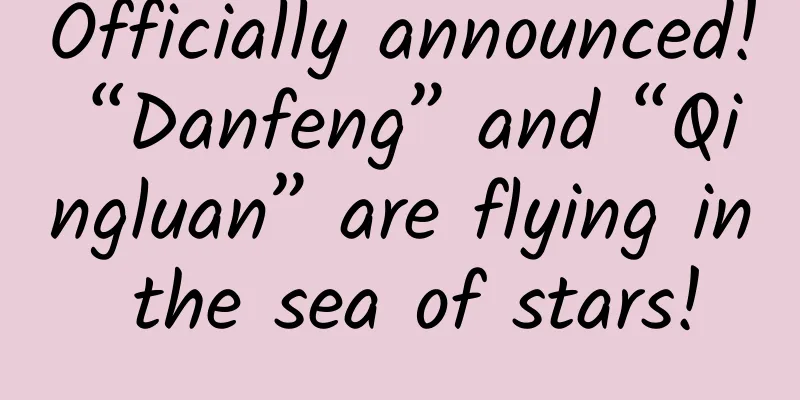Officially announced! “Danfeng” and “Qingluan” are flying in the sea of stars!

|
On the afternoon of June 17, 2023, the "International Astronomical Union (IAU) NameExoWorlds 2022 - China Naming Results Release Conference" came to a successful conclusion at the Beijing Planetarium 4D Science Theater. This press conference is one of a series of popular science activities carried out by the Chinese Astronomical Society in 2023. It is hosted by the Chinese Astronomical Society, undertaken by the Beijing Planetarium, and co-organized by the China Center of the Astronomical Education Office of the International Astronomical Union. It is broadcast live online simultaneously through the Beijing Planetarium WeChat Video Account and Sohu Video, and announced the Chinese team's naming proposals for the Tucana star L 168-9 and its planet L 168-9b adopted by the IAU - Danfeng and Qingluan. The "NameExoWorlds 2022" event of the International Astronomical Union received 603 nominations from 91 countries and regions. After fierce competition, 20 proposals were nominated, and the naming proposal of the Chinese team was successfully selected! The other 19 exoplanet system naming teams came from Kenya, Thailand, Chile, the United States, Spain, Hungary, Puerto Rico, Tunisia, Greece, Mexico, Costa Rica, Colombia, Bahrain, Australia, Romania, Croatia, Cameroon and South Korea. At the press conference, Professor Wang Xiaofeng, Director of the Beijing Planetarium and Director of the Popularization Committee of the Chinese Astronomical Society, unveiled the nameplates of the stars "Danfeng" and "Qingluan", and introduced these two names full of oriental charm, and looked forward to the subsequent popularization of science. The parent star L 168-9 is a red dwarf star, named "Danfeng", which refers to the red phoenix, a divine bird that symbolizes auspiciousness in ancient Chinese mythology and legends. The planet that orbits it quickly is named "Qingluan", which is a divine bird belonging to the phoenix in ancient legends, also known as the blue bird. It is swift and busy, and is also a messenger of love. The well-known poem by Li Shangyin, "The blue bird is diligent in exploring", left its beautiful name. Danfeng and Qingluan, these two names are very consistent with the nature of this planetary system, reflecting the organic combination of astronomy and traditional Chinese culture, and will also allow the world to further understand the profound heritage of Chinese civilization. Wang Xiaofeng, Director of the Popularization Committee of the Chinese Astronomical Society and Director of the Beijing Planetarium, unveiled the nameplates of the stars "Danfeng" and "Qingluan" and delivered a speech. Director Wang Xiaofeng and Researcher Lu Ye presented certificates to the naming team Cao Chen, the main contact person for the naming event in China, a member of the Popularization Working Committee of the Chinese Astronomical Society, and a teacher at Shandong University (Weihai), introduced the progress of this event. In August 2022, the IAU began to collect naming schemes for exoplanets worldwide. The naming objects of this event are the 20 exoplanet system targets that the James Webb Space Telescope (JWST) will observe in the first batch. The participants of the event are teams composed of professional and amateur astronomers, astronomy enthusiasts, students, teachers, etc. They are required to carry out astronomical science popularization activities related to exoplanets and name one of the above 20 systems. Each system has a known exoplanet and its parent star. The names of the star and the planet are connected by a common theme. Cao Chen, the main contact person for the Chinese naming event, member of the Popularization Committee of the Chinese Astronomical Society, and teacher of Shandong University (Weihai), introduced the event The teams in mainland my country submitted 52 valid naming proposals, with a total of 550 members participating in the nomination team. Various offline or online science popularization activities related to exoplanets organized by the Chinese Astronomical Society have benefited more than 85,000 audiences. The Chinese Astronomical Society commissioned the Popularization Working Committee to establish the "Exoplanet World Naming-China Plan Selection Expert Group", which consists of 15 astronomy research and science popularization education experts from major observatories, planetariums, colleges and middle schools in my country. They then conducted four rounds of detailed review and discussion on the above proposals, comprehensively considering the personnel composition of each nomination team, science popularization activities and the quality level of the naming proposals, and finally selected 1 candidate proposal and 2 backup proposals to be submitted to the IAU, and also selected 24 excellent domestic naming proposals. Wang Xuesong, a member of the naming proposal team and co-discoverer of Qingluan, a professor at Tsinghua University, also came to the scene to introduce the scientific research process and stories behind the search and identification of exoplanets, and shared the latest progress in exoplanet research. Professor Wang said that Qingluan is larger than the Earth, but we don’t know its color and surface composition yet, and we are not sure whether it has oceans and atmosphere. Just a few days before and after this press conference, the Webb Space Telescope is conducting three observations of it to study its atmospheric composition. One of the discoverers of Danfeng Star and a member of the naming team, Professor Wang Xuesong from the Department of Astronomy at Tsinghua University, gave a wonderful science report Zhang Junbo, a representative of the naming team and a teacher at the National Astronomical Observatory of the Chinese Academy of Sciences, shared her experience from forming the team to submitting the naming proposal, and expressed her gratitude to all the units and individuals who provided help. She said that the name of Tucana is related to the love story of Zeus and Hera, and that the blue phoenix is often used as a messenger of love in Chinese mythology. The cultural connotation and the physical properties of the celestial body itself were the two main points that the team focused on during multiple brainstorming sessions. The naming team representative, Professor Zhang Junbo from the National Astronomical Observatory, shared the naming stories of Danfeng and Qingluan. The naming team members of Danfeng and Qingluan include: Zhang Junbo (National Astronomical Observatory, Chinese Academy of Sciences), Gong Boyang (The Affiliated High School of Renmin University of China), Zhao Fei (National Astronomical Observatory, Chinese Academy of Sciences), Wang Xuesong (Department of Astronomy, Tsinghua University, one of the co-discoverers of the exoplanet), Qiao Yike (The Affiliated High School of Renmin University of China), Xia Shetian (The Affiliated High School of Renmin University of China), Wang Minxing (The Affiliated High School of Renmin University of China), Zhang Jinchen (The Affiliated High School of Renmin University of China), Liang Lixian (National Astronomical Observatory, Chinese Academy of Sciences), and Fan Zhou (National Astronomical Observatory, Chinese Academy of Sciences). It is their hard work and wonderful proposals that made the Chinese proposal win in the 2022 exoplanet naming event, and made Danfeng and Qingluan become the new business cards of Chinese culture. Researcher Lu Ye, Director of the Science Popularization and Informatization Center of the National Astronomical Observatory of the Chinese Academy of Sciences and Deputy Director of the Popularization Working Committee of the Chinese Astronomical Society, congratulated the naming team and emphasized the important role of astronomy in the development of other branches of natural sciences and human society, and its importance in establishing cultural confidence. He hoped that this event would attract more people to pay attention to scientific and cultural knowledge and love traditional culture, and called on everyone to actively participate in more science popularization activities of the Chinese Astronomical Society. Lu Ye, deputy director of the Popularization Committee of the Chinese Astronomical Society and researcher at the National Astronomical Observatory, delivered a speech The host, Li Jian, a researcher at the Beijing Planetarium, also thanked all 550 teachers and students from 52 teams who participated in the naming event. The fact that China's naming proposal was selected also depends on the contributions of the other 51 nominating teams, 540 teachers and students. It is because of everyone's wisdom and concerted efforts that we can select the best from the best, let the Chinese proposal stand out, and let the world embrace Chinese civilization! The "Danfeng" and "Qingluan" stars are flying in the universe, and the beautiful stories of Danfeng and Qingluan will be passed down from generation to generation in human civilization. Li Jian, deputy director of the China Center of the International Astronomical Union's Astronomy Education Office and research curator of the Beijing Planetarium, hosted the press conference Finally, Mr. Zhu Jin, leader of the expert group for selecting Chinese proposals for the naming activity of extrasolar worlds, researcher at the Beijing Planetarium, and editor-in-chief of "Astronomy Enthusiast" magazine, made a summary speech online. On behalf of the expert group for selecting Chinese proposals for the naming activity of extrasolar worlds, he congratulated the nominated teams, expressed gratitude to all the Chinese teams that participated in the naming activity, and looked forward to more people participating in future naming activities. Zhu Jin, a researcher at the Beijing Planetarium and the leader of the Chinese selection expert group for the naming of extrasolar worlds, sent a video summarizing the event. Link: Danfeng Star and Qingluan Star Archives Constellation: Tucana The main star Danfeng is a red dwarf star with a radius of 0.6 times that of the sun and a mass of 0.6 times that of the sun. It has an effective temperature of 3800 Kelvin, a very low temperature, and is a very red star. Planet Qingluan: 1.4 times the size of Earth, 4.6 times the mass of Earth, orbital period 1.4 days, orbital semi-major axis 0.02 AU (AU is the average distance from the sun to the earth). Surface equilibrium temperature is about 965 Kelvin, or nearly 700 degrees Celsius, making it a very hot super-Earth. |
Recommend
A perfect ending! Goodbye, Tianzhou-3
The Tianzhou-3 cargo spacecraft re-entered the at...
Are there dragons in your hometown? Maybe there are no dragons in the world...
There are no dragons in this world. Because the C...
Jiangsu College Entrance Examination Liberal Arts Champion failed to get into Tsinghua University and Peking University. Why? Huaiyin Middle School Bai Xiangling's total college entrance examination score
In this year's Jiangsu college entrance exami...
Review: NetEase Kaola’s Double 11 integrated marketing strategy!
I have been searching for spring for half my life...
Will artificial intelligence drive down house prices?
On October 13, the US government issued two repor...
Gehua Cable TV will be the next Wasu Media
Gehua Cable sells a large order of 33 yuan On Marc...
How much does it cost to invest in Huzhou’s annual vehicle inspection app? What is the investment price of Huzhou Automobile Annual Inspection Mini Program?
How much does it cost to recruit investors for th...
When flying, where is it safer to sit? What to do if you encounter turbulence?
In recent days, civil aviation passenger plane ac...
Value 50: Find the 50 most valuable stocks in China
Value 50: Find the 50 most valuable stocks in Chi...
Note that it’s not the memory! Who is affecting the storage (ROM) performance of the mobile phone?
Just like the main hard disk of new PCs has been ...
The three chip giants have entered the autonomous driving market, and Chinese manufacturers such as Huawei have made a single breakthrough and are facing the ultimate test
Qualcomm, Intel and Nvidia, the three giant chip ...
One Year Notes for iOS Programmers - Learning
[[140168]] Text/Some Bird Preface Before I knew i...
Long March 5B is ready!
On July 18, the Wentian Experimental Module and t...
APP promotion tips: how to tap into iOS channels
Question 1: I don’t know where to tap into the iO...
Three Mentality of Chinese People When Buying Mobile Phones
Buying a mobile phone is a complicated process. T...









